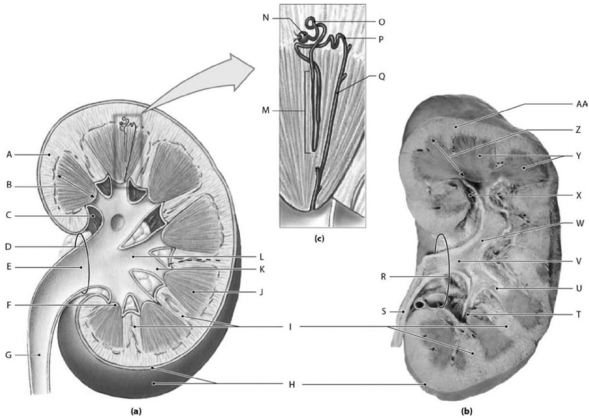A) transport urine,as well as semen,in males.
B) are covered by a layer of muscularis mucosa.
C) conduct urine to the exterior.
D) produce urine.
E) temporarily store urine prior to elimination.
Correct Answer

verified
Correct Answer
verified
Multiple Choice
ANP release is stimulated when
A) angiotensin I is converted to angiotensin II.
B) the rate of sodium ion reabsorption is decreased.
C) urinary water retention is too high.
D) glomerular filtration is increased.
E) blood volume and blood pressure are too high.
Correct Answer

verified
Correct Answer
verified
Multiple Choice
When one eats a high-sodium meal,why does it not raise the sodium ion concentration of body fluids?
A) The osmolarity of the ECF falls.
B) Osmosis moves water from the digestive epithelium to the ECF.
C) Both the ECF and the ICF become more dilute.
D) There is an increase in the volume of the ICF.
E) Water is exchanged for sodium chloride as it crosses the digestive epithelium.
Correct Answer

verified
Correct Answer
verified
Multiple Choice
 -Label T represents which of the following structures?
-Label T represents which of the following structures?
A) renal papilla
B) renal columns
C) renal cortex
D) major calyx
E) minor calyx
Correct Answer

verified
Correct Answer
verified
Multiple Choice
The cup-shaped chamber,or the expanded end of a nephron,is known as the
A) glomerulus.
B) glomerular capsule.
C) proximal convoluted tubule.
D) distal convoluted tubule.
E) loop of Henle.
Correct Answer

verified
Correct Answer
verified
Multiple Choice
What is the primary role of the carbonic acid-bicarbonate buffer system?
A) buffer the pH of the ICF
B) contribute to the regulation of pH in both the ECF and ICF
C) provide extensive buffering capability in the ICF of active cells
D) prevent pH changes caused by organic (metabolic) acids
E) provide the use of amino acid side groups in response to pH changes
Correct Answer

verified
Correct Answer
verified
Multiple Choice
When the level of ADH (antidiuretic hormone) increases,
A) the rate of sodium ion reabsorption in the DCT decreases.
B) more concentrated urine is produced.
C) less water is reabsorbed by the nephron and collecting duct.
D) the water content of urine increases.
E) the sensation of thirst is inhibited.
Correct Answer

verified
Correct Answer
verified
Multiple Choice
Major calyces are
A) drains that combine to form the renal pelvis.
B) expanded ends of nephrons.
C) basic functional layers of the kidney.
D) the site of exit for the ureter.
E) the expanded ends of renal pyramids.
Correct Answer

verified
Correct Answer
verified
Multiple Choice
To achieve fluid balance,ion concentration gradients are eliminated by
A) osmosis.
B) diffusion.
C) active transport.
D) pinocytosis.
E) facilitated diffusion.
Correct Answer

verified
Correct Answer
verified
Multiple Choice
The micturition reflex begins to function when
A) the stretch receptors have provided adequate stimulation to the sympathetic motor neurons.
B) the stretch receptors have provided maximum stimulation to the parasympathetic motor neurons.
C) the stretch receptors have provided adequate stimulation to the parasympathetic motor neurons.
D) the stretch receptors have provided maximum stimulation to the sympathetic motor neurons.
E) the stretch receptors are initially distorted.
Correct Answer

verified
Correct Answer
verified
Multiple Choice
Water movement between the ECF and ICF is called
A) incontinence.
B) metabolic generation of water.
C) urinalysis.
D) diuretic factor.
E) fluid shift.
Correct Answer

verified
Correct Answer
verified
Multiple Choice
 -Label C represents which of the following structures?
-Label C represents which of the following structures?
A) hilum
B) renal pelvis
C) renal cortex
D) renal medulla
E) renal sinus
Correct Answer

verified
Correct Answer
verified
Multiple Choice
 -Label Y represents which of the following structures?
-Label Y represents which of the following structures?
A) renal papilla
B) renal columns
C) renal pyramids
D) major calyx
E) minor calyx
Correct Answer

verified
Correct Answer
verified
Multiple Choice
The following is a list of the blood vessels that carry blood to the kidney: 1.afferent arteriole 2.arcuate artery 3.interlobar artery 4.renal artery 5.glomerulus 6.cortical radiate artery 7.efferent arteriole 8.peritubular capillary The proper order in which blood passes through these vessels is
A) 4,6,2,3,1,5,7,8.
B) 4,3,2,6,1,5,7,8.
C) 4,3,2,6,7,5,1,8.
D) 4,6,2,3,7,5,1,8.
E) 4,3,6,2,1,5,7,8.
Correct Answer

verified
Correct Answer
verified
Multiple Choice
 -Label F represents which of the following structures?
-Label F represents which of the following structures?
A) renal papilla
B) renal columns
C) renal cortex
D) major calyx
E) minor calyx
Correct Answer

verified
Correct Answer
verified
Multiple Choice
Which of the following transports urine from the kidney toward the bladder?
A) small intestine
B) prostate
C) liver
D) ureter
E) urethra
Correct Answer

verified
Correct Answer
verified
Multiple Choice
Hypoventilation is usually the cause of
A) respiratory acidosis.
B) respiratory alkalosis.
C) metabolic acidosis.
D) metabolic alkalosis.
E) hyponatremia.
Correct Answer

verified
Correct Answer
verified
Multiple Choice
 -Label AA represents which of the following structures?
-Label AA represents which of the following structures?
A) hilum
B) renal pelvis
C) renal cortex
D) renal medulla
E) renal sinus
Correct Answer

verified
Correct Answer
verified
Multiple Choice
Urine ejection cannot occur unless which event(s) takes place?
A) Both the internal and external urethral sphincters are contracted.
B) The internal urethral sphincter is relaxed,and the external urethral sphincter is contracted.
C) The internal urethral sphincter is contracted,and the external urethral sphincter is relaxed.
D) Only the internal urethral sphincter is contracted.
E) Both the internal and external urethral sphincters are relaxed.
Correct Answer

verified
Correct Answer
verified
Multiple Choice
With increasing age,
A) the number of functional nephrons increases.
B) the sensitivity to ADH and aldosterone increases.
C) the total body water content increases.
D) instances of kidney problems increase.
E) the body mineral content increases due to the deterioration of bone.
Correct Answer

verified
Correct Answer
verified
Showing 21 - 40 of 114
Related Exams